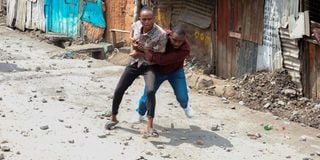Kenya’s response to cost-of-living protests unsettling

A plainclothes policeman arrests a man in Mathare slum, Nairobi on July 19, 2023, during the demonstrations called by Azimio la Umoja over the high cost of living.
Government is facing a barrage of local and international condemnation for the brutal manner in which it cracked down on protests against the escalating cost of living.
At least 30 people have been killed since the protests began in March. Hundreds more have been injured.
Last Sunday, I accompanied Governor Gladys Wanga as she visited some of the victims in their homes and at the Homa Bay Referral Hospital. One old man was shot in the leg inside his compound. A young graduate teacher was shot on the shoulder from the back.
Protests began soon after the UDA administration tabled the budget policy paper in Parliament mid-February. In it, the regime detailed their plans to increase taxes by Sh300-400 billion per year for the next five years.
The regime responded to the March protests by offering bi-partisan talks, which collapsed when it became clear that the negotiating committee could not deal with the cost of living.
Protests resumed and escalated in July. The immediate trigger was the enactment of the Finance Act 2023.
In particular, the doubling of value added tax on petroleum products has had the immediate effect of increasing pump prices.
Protests against escalating cost of living are not unique to Kenya, but the regime’s reaction has been unusually brutal. The high number of fatalities, arrests, detention and gross violation of human rights is comparable only to what is happening in Kazakhstan.
Last year alone, more than 12,500 protests were staged in 4,630 unique locations, in 148 countries around the world, according to data by the Armed Conflict Location and Events Data Project.
There were protests in France, the UK, Germany, South Africa, Argentina, India, Indonesia, Pakistan, Sri Lanka, Mexico, Turkey, Ecuador, Venezuela, Sierra Leone, Bangladesh and Cuba.
Fiscal management
The protests were in all regions except Antarctica. Fiscal mismanagement, conditions attached to IMF loans and government failure to protect citizens in the wake of sharp price increases were the main concerns.
The citizens complain about increases in the prices of fuel, gas, electricity and food. Major protests followed cuts to energy subsidies. In the UK for example, Don’t Pay UK is a grassroots movement demanding a fair price for energy for everyone; to prevent people dying from the cold in winter.
Globally, the Kazakh and Kenyan authorities stand out. They seem particularly nervous about the cost-of-living protests, responding with arbitrary arrests, detentions, violent clashes and death.
In both countries, police brutality has seen the protests degenerate into larger security crises resulting in many fatalities.
Controlling inflation is one of the key aims of all governments. Sharp rises in prices mean steep declines in public wellbeing. Citizens find that their incomes can now only afford them far less goods and services than before.
And with populations so restive globally, governments are hoping that the bitter pill of high interest rates works faster in taming inflation.
The US Fed has just increased interest rates again to 5.5 per cent, the highest in 22 years. This has put pressure on emerging markets. Locally, foreign investors are selling off stocks in the Nairobi Securities Exchange to invest in US assets, which now provide higher returns. It also has the effect of weakening the Kenyan shilling.
A weak shilling is putting more pressure on inflation because we are a net importer with a rather high oil bill and a large trade deficit. The US and Europe are the main sources of diaspora remittances.
With these economies also struggling, remittances are down 16 per cent since the beginning of the year. Remittances and portfolio flows are usually sufficient to cover the trade deficit. With both slowing down, the shilling is at an all-time low.
If the cost-of-living protests are taking place around the world, what is unique about Kenya? Three things. First, although the administration acknowledges there is a cost of living crisis, they appear intent on making it worse.
They not only removed fuel subsidies, but doubled taxation on fuel, sending ripples across the economy. In addition, heavy domestic borrowing has sent interest rates spiralling, making things worse. Rather than finding real solutions, the top leadership has focused on blaming the previous administration as well as the opposition!
Second, the Central Bank and Treasury leadership are completely mute as the crisis unfolds, giving the impression of a plane on auto-pilot as it veers off course. The monetary policy is completely at odds with spending plans.
The regime is relying heavily on domestic borrowing at a time when Central Bank is aggressively increasing interest rates. This has sharply increased financing costs for both public and private sector, slowed down private sector credit, and increased non-performing loans, all of which have dimmed economic prospects.
Third, perhaps because it squeezed into office with a rather thin margin, the regime is too jittery, responding to slightest criticism with an iron fist. Their pace is frenetic. Hundreds of high-level meetings and travel with little result.
They are desperate for projects to “launch”, resulting in the bizarre situation where projects are launched more than once.
Immediately after the elections, the regime embarked on a campaign to co-opt opposition members to the government side. These manoeuvres enabled the administration to enact unpopular taxation measures. But it is the regime’s response, which ignores the constitution and suspends human rights that makes Kenya stand out.
@NdirituMuriithi is an economist


